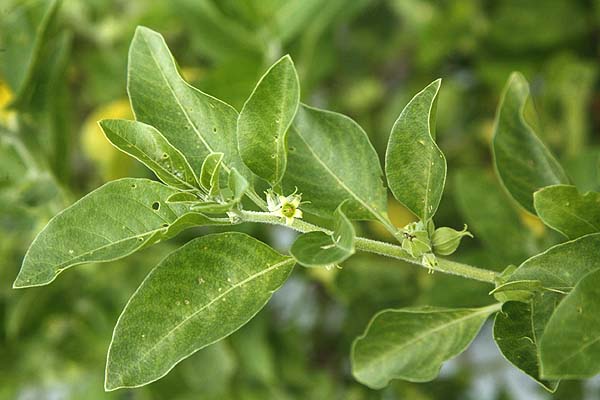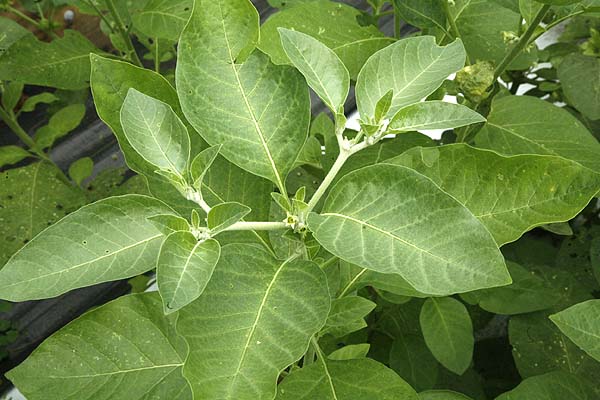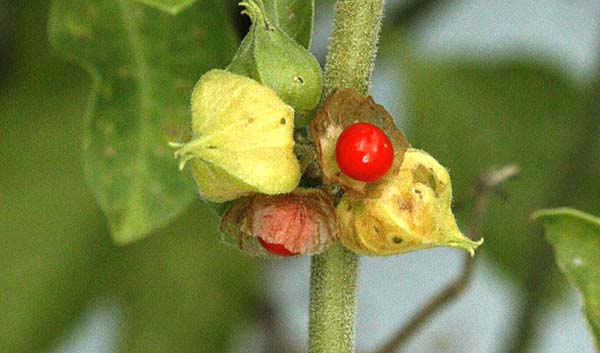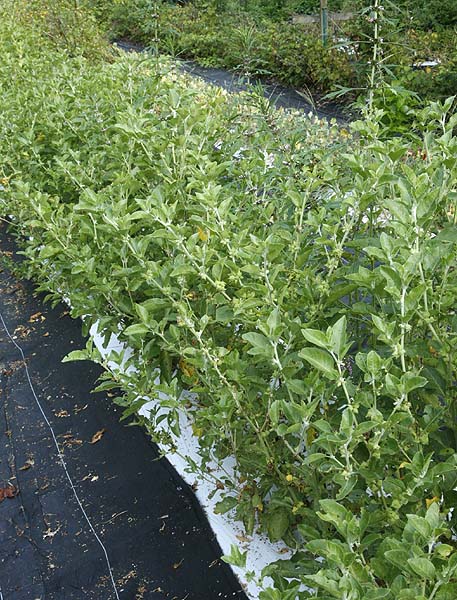An shrubby bush like plant that is hardy in warmer zones (8b and warmer) but grown as an annual in all others. Grown mostly for its powerful herbal roots Ashwagandha can grow large roots in one year. Its an attractive plant and while its tiny green flowers are inconspicuous the red berries that follow are interesting visually. Very easy to grow and will reach four feet in one year. This powerful herb has been used for centuries in India and other Eastern countries and is one of the best herbs for combating stress and a multitude of other complaints. Its what is known as an adaptogen meaning if taken over time it can slowly bring the body back to a healthy balance and restore good health while increasing energy and vitality. While harvesting the roots can be a little time consuming the leaves do have similar properties but much milder.
Description of Ashwagandha (Withania somnifera).
Growing Ashwagandha (Withania somnifera) from Seed.
Location and Care of Ashwagandha (Withania somnifera).
Since the roots will need to be dug at the end of the season pick the location of your plants well. Do not put near other plants that you don't want disturbed during autumn digging. Ashwagandha is best grown in its own bed or a row where digging is easy access.
Be aware that this plant can grow quite tall so pick your spot well so it wont overshadow other shorter plants. Space plants about 24 inches (61 cm) apart to allow for good above ground shrub development and give the roots space to spread. Plants will grow to about 4 feet (1.2m) in height and spread to 3 feet wide (1 m). Adding good organic material to the soil to improve soil structure and add nutrients. The amount you add will depend on your soil development. About a 25% capacity is usually effective for this plant. Plant in looser well broken up soil not a hard pan as you will be digging the plant up again and removing the roots make the job easy on yourself and prepare the soil in advance.
Water well on transplanting and occasionally once established. How much water you add will depend on your soil type and rainfall. Sandy soil will need more water than other soils that have slower drainage. While Ashwagandha is quite drought tolerant and does thrive in low water areas it will not grow as tall or develop larger roots in one season if not given at least some water. Using a soaker hose or drip irrigation tape is the best way of providing small amounts of water close to the roots without overwatering.
While some fertilizer can be added its best to use a good organic one and only sparingly. How much you feed will depend on your location soil type and plant health. Check the plant leaves for any signs of deficiency - yellowing leaves, discoloration and of course pests. If the plant is attacked by pest more feed will be needed to help it fend off any problems. Use a good organic fertilizer usually one made from seaweed provides what this plant requires.
Growing in Pots.
Pests and Diseases of Ashwagandha (Withania somnifera).
The main problem this plant seems to suffer from is three lined potato beetles (Lema daturaphila). These annoying bugs do not attack potatoes or tomatoes but usually feed on ground cherries the wild cousin of the plants in this family we cultivate (potatoes, tomatoes, golden berries). It does however love Ashwagandha and will lay its eggs on the tips of the branches. These are followed by disgusting looking slug like larvae that have tiny legs that can eat the bush to the ground. There are several ways to deal with this pest.
1. Plant later in the year, not in the early spring. This will miss the initial flight and breeding of the bugs so the don't find your plants and breed. This method will not work however if you have a lot of ground cherries on your property, or your neighbours. It relies on there not being a early food source for the bugs close by.
2. If you have to spray use Neem oil. It works very well, may need a couple of coatings but its organic and does little harm to any other plants. Get a good quality high concentration oil.
3. Use biological control. If you have preying mantids on your property, every time you find one catch it and dump it on the Ashwagandha - or any other plant you are having problems with. We use this method for our Ashwagandha and it works very well. There is always some initial leaf loss when the problem is first discovered and a lag until the mantids get working on the problem they tend to clean up the bugs quite well and keep more from attacking. While I don't think the mantids eat the eggs they certainly eat the larva and the adults who come to lay more eggs. If you have a large patch of Ashwagandha you will need quite a few mantids to get it clear but it does work. If you don't have mantids on your property naturally you can purchase egg cases and hatch your own. Of course the lag in cleanup will be a lot greater if you are starting late with baby mantids but the little guys grow really fast. Just don't freak out when you see the large bugs hanging out on your plants. Note: Mantids will eat any bugs good or bad so be aware you may loose some good bugs along with the pests.
Plant family and pest control of Ashwagandha (Withania somnifera).
Harvesting Ashwagandha (Withania somnifera).
Use a fork and carefully dig out each plant, follow roots along and carefully remove each root. Place in a wheel barrow or large container. Digging roots can be very time consuming especially if the Ashwagandha is surrounded by other plants you don't want to dig up. (hence good choice of location) or if your soil is heavy. Ensuring you have well prepared your soil so it is light and easy to dig as possible will make this task easier.
If you are in a low zone (5 and above) its possible that your Ashwagandha may not flower. In this case just dig the roots before frost. Do not attempt to cover roots they will not survive a freeze. If you want to grow for more than one year either grow in pots or a heated greenhouse. A unheated hoop house will not keep the roots warm enough even in zone 7b.
Root preparation.
Leaves. While not as commonly used the leaves also have similar properties to the roots but milder. Harvest healthy leaves throughout the growing season ensuring they are fully formed and have not been attacked by blights or disease. These can then be dried for later use.
Culinary Uses of Ashwagandha (Withania somnifera).
Roots can be powered and added to food. While I have seen this many places on the internet unless you are producing a very heavily spiced dish its not recommended this stuff is bitter and unpleasant. This is why its usually taken in tincture form or in a capsule.
The leaves while not commonly used medicinally do have milder properties but are not as pungent as the roots so may be more conducive to being used in foods.
Medical uses of Ashwagandha (Withania somnifera).
Ashwagandha is used for a multitude of problems but one of the main ones it is known for all concern the nervous system, stress and stress related issues such as anxiety, headaches, sleep quality and depression. In India it is one of the most wildly used tranquillizers and help to improve vitality and recovery after any serious illness.
Much research has been done involving this herb each piece seeming to reveal yet another aspect of its properties and uses. Several companies are exploring it for use in cancer treatments where it has been used herbally in Ayurvedic medicine for a long time. Another major use concerns reproductive issues for women its helping to tone the uterus after miscarriage, aid in post-partum difficulties and combat infertility. In men it's to help with impotence and is considered an aphrodisiac for both genders.
While most adaptogens have many properties Ashwagandha seems to have more than most. Take over time its ability to nourish all body systems and gently move the body back into proper alignment and health is why so many issues are listed as being helped by this herb. As well as those listed above these include but are not limited to:
- Improving memory loss
- Fever reduction
- Inflammatory conditions of all kinds such as bronchitis, asthma and psoriasis
- Reducing pain and swelling due to arthritis and painful joints in general
- Failure to thrive in children and promoting their growth
- Nervous exhaustion,
- Improving blood cell health including iron levels which will treat anemia
- Enhancing immune function and for low white blood cell counts
- Shrinking tumors
- Improving wasting diseases and multiple sclerosis
- Normalizing cholesterol levels
- Helping to treat diabetes
- Improving stamina in athletes
In addition the plant can be used externally most commonly powdered root is mixed with oil or water to form a p poultice that is applied to boils, bites and stings as well as abnormal swelling and skin trauma.
Other uses of Ashwagandha (Withania somnifera)
Reports state that the fruit is rich in saponins and can be used as a soap substitute. Fruits need to be picked as they ripen before they dry out. This is fiddly and time consuming. Other reports state the leaves are a insect repellent however they do not state how leaves should be prepared.
Other names.










